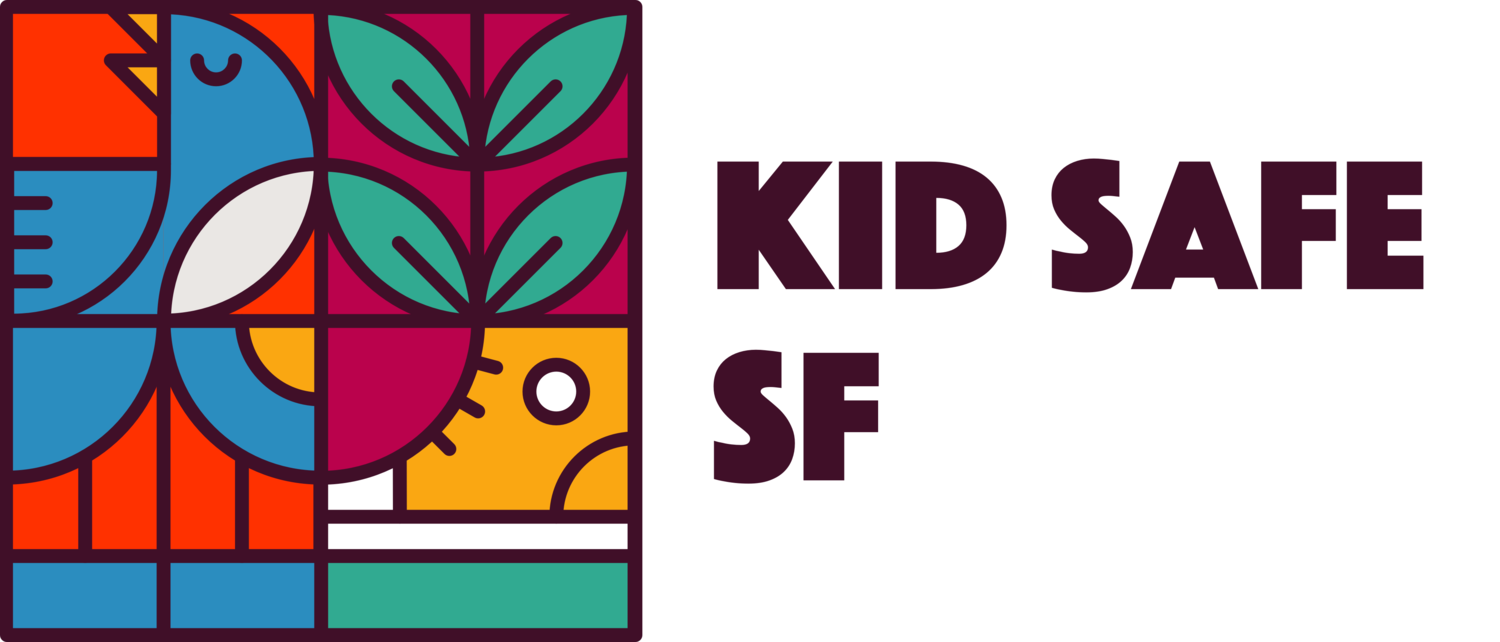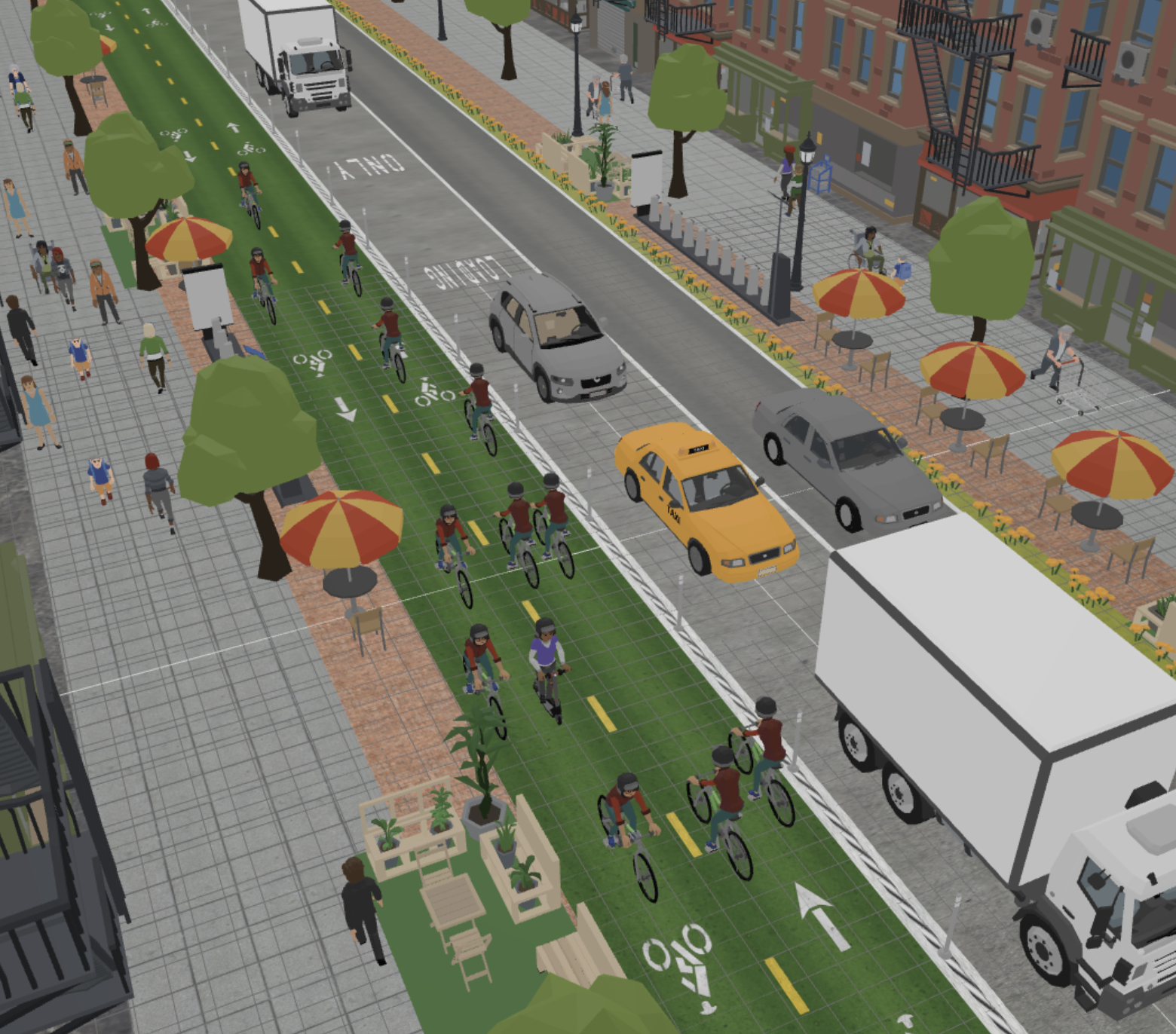A Vibrant, Kid-Safe Valencia for Everyone: Let’s Pilot a Greenway on Valencia
SFMTA has released proposed designs for a center-running protected bikewayon Valencia between 15th St and 24th St. Attend the virtual open house and comment on the proposed designs.
KidSafe SF has safety concerns about the center-running design that we believe should be addressed primarily by piloting a different concept, the Burrito Plan, which calls for one-way vehicle traffic, a dedicated loading and delivery lane, a two-way cycletrack, and expanded space for pedestrians and parklets.
Regardless of which design SFMTA pursues during the pilot, SFMTA should improve safety features of their plan, continue the successful weekend promenades, and plan now for a future Valencia that prioritizes the needs of people and businesses, reduces cut-through traffic, and creates a vibrant, world-class merchant corridor.
The next two weeks are crucial to demand bold change for Valencia Street through SFMTA’s Mid-Valencia Virtual Open House. Kid Safe SF wants to improve safety, livability, and community on Valencia Street by creating space that puts people first. We want to see the SFMTA prioritize safety, active transportation, commerce, and proactive climate action, while maintaining necessary vehicle access and loading space.
To do this, we call on SFMTA to test an ambitious design that prioritizes safety by piloting the Burrito Plan on Valencia and continuing the weekend Shared Spaces car-free promenade.
We encourage everyone to review SFMTA’s design and send feedback asking for a better design, a pilot of the Burrito Plan, and continued car-free Shared Spaces on Valencia. Sign our petition for updates on how to help advocate for a better Valencia Street.
We’re thrilled that SFMTA is returning to Valencia Street after its commitment to deliver protected bikeways 2022, a commitment only won after activists took to the street to demand action. We’re glad to see such broad agreement between merchants, advocates, and SFMTA on the urgent need for protected bike lanes and appreciate how the proposed center-running bikeway design can be implemented quickly.
However, the proposed center-running bikeway falls far short of what’s needed to create a street that works for everyone, especially space for kids and active mobility users of all ages and abilities. The wild success of the car-free Shared Spaces promenades has demonstrated that experimenting with a bolder people-first vision for Valencia is not just possible, but the best choice to keep Valencia thriving for merchants, neighbors, visitors, and cyclists alike.
To do this, Kid Safe SF calls on SFMTA to build a better Valencia by piloting the Burrito Plan while continuing the weekend Shared Spaces car-free promenade.
The Burrito Plan Explained
The Burrito—what? The Burrito Plan is a bold community-led design that puts people first by shifting car space to people space. It offers a wide two-way protected cycletrack safe for kids, more space for pedestrians and parklet zones, while still providing one-way local vehicle and driveway access, loading zones, and blue zone accessible parking for people with disabilities. Instead of a bikeway sandwiched between speeding SUVs, the Burrito Plan shifts car traffic to one side of the street.
While unsettling, the center-running bikeway does present an opportunity to pilot the Burrito Plan along the corridor. For the Burrito pilot, one side of the roadway would be transformed into a promenade, with local vehicle access and loading zones on the other side.This wider promenade would create more room for Shared Spaces and alleviate the crowded sidewalks.
Right now, Valencia Street is trying to do too much: it’s a thriving commercial corridor; the city’s premier north-south bike connector; a destination for deliveries and loading; host to outdoor dining and retail; home to overcrowded sidewalks; and a through street for car traffic. All these uses can’t mix safely, so Valencia has long been one of the city’s most dangerous streets. Something has to give, and it can’t be our safety. City leaders need to prioritize space for people. By de-emphasizing cut-through vehicle traffic, we’ll create new safe spaces for kids, cyclists, pedestrians, and commerce.
Valencia’s incredible small businesses are a large part of what makes it special. We know that creating space for people isn’t just the right thing to do; it’s good for business too. SFMTA commissioned a third-party shopper survey in 2018 that found 70% of visitors get to Valencia by walking, biking, or riding transit and that people who biked spent more than double at Valencia merchants than those who drive or ride-hail to the corridor, on average. The majority of Valencia’s limited space should prioritize the 70% who have chosen sustainable transportation to visit Valencia merchants over the minority that is private cut-through traffic.
Safety concerns with a center-running bike lane
Safety with center-running bikeways is a significant concern. Center-running bike lanes are not an all ages and abilities safe design for kids, seniors, and other vulnerable road users. SFMTA’s own FAQ says that center-running bikeways in other cities led to "an adjustment period" with "an uptick in collisions." We don’t want to be nearby while drivers “adjust.”
Drivers making illegal left and U-turns across the bikeway will pose an extreme hazard to cyclists. For instance, SFMTA can’t stop drivers from routinely making illegal turns into center-running Muni trains on Third Street, yet they plan to put cyclists’ bodies in the same position as 40-ton trains.
The center-running bikeway design offers no additional space for pedestrians. In particular, people with mobility impairments, who currently face accessibility challenges on Valencia’s overcrowded and often blocked sidewalks, gain no relief.
No protection is planned for Valencia south of 24th St, leaving another dangerous gap in the network, and no timeline has been offered to complete this project.
Lessons from other cities on center-running lanes
SFMTA compares their design to center-running bikeways in Washington DC and Monterey. However, those streets are very different from Valencia (Pennsylvania Avenue is an eight-lane thoroughfare, while Valencia is a thriving commercial district), those designs incorporate more physical protection, and the local advocates at Bicycling Monterey are not fans of that design, citing safety, access, and ease of use challenges.
The Pennsylvania Avenue bikeway that SFMTA cites as a model for Valencia saw 16 reported bicycle crashes during the first 14 months, the majority of which were caused by drivers making illegal turns across the bike lanes, according to a report co-authored by a planner who coincidentally now serves as SFMTA’s Director of Livable Streets. The crash frequency increased even after accounting for the larger number of bicyclists on the street.
Washington DC is currently considering removing the center-running bikeway from Pennsylvania Avenue in favor of bold new designs with fewer car lanes and more space for people. We should be designing Valencia for the future, not using an outdated and unsafe model that peer cities are actively replacing.
A path forward for a safer, more vibrant Valencia
Because of these concerns, we believe the best path forward for Valencia is to de-prioritize through vehicle traffic, freeing up space for safety and people. SFMTA should commit to test the Burrito Plan in its pilot so neighbors, merchants, cyclists, and pedestrians can all try it out and provide informed feedback.
Regardless of the design used for the pilot, we believe SFMTA should commit to the following to ensure a Valencia that’s both Kid Safe and good for merchants:
Include hard barriers between bicycles and any vehicle traffic—not just flimsy flexible posts—as was done in Monterey
We believe safe infrastructure should be self-enforcing, but if SFMTA proceeds with a design that requires enforcement, provide a parking enforcement presence for the duration of the pilot to reduce dangerous turns across the bike lane and illegal parking
Design additional physical measures to prevent dangerous illegal turns across the bikeway
Ensure access for cyclists of all ages and abilities to mid-block business
Commit to a firm timeline to deliver protected bike lanes south of 24th St
Establish target metrics for vehicle volumes, speeds, safety, and bikeway obstructions and commit to immediately implementing new designs if the center-running bikeway doesn’t work
Promote all modes of transportation to Valencia by improving signage to direct visitors to nearby fast and frequent Muni and BART service and drivers to convenient parking options, including the hundreds of city-owned garage spaces within a block of Valencia
Everyone can benefit from a kid-safe Valencia, especially the most vulnerable road users
Active mobility users on Valencia include large numbers of food delivery workers along with restaurant and service industry workers using bikes and scooters after their shifts when transit is limited. Treating gig workers well means creating safe loading zones that serve everyone’s needs rather than exposing them to the risk of punitive tickets for a parking situation that’s outside of their control. The dedicated loading and short term parking zones in the Burrito plan will help improve curb management, a stated goal of SFMTA’s current Valencia work.
Valencia includes four K-8 schools with many families who walk, bike, and scoot to school and need safety. Designing a bikeway that’s safe for kids can help shift school trips to sustainable modes.
Finally, the Burrito Plan or any safer road design will likely benefit merchants most of all. 70% of shopper survey respondents get to Valencia by walking, biking, or riding transit, yet the existing street design prioritizes the minority who arrive by car at the expense of everyone else’s safety. People who biked spent more than double at Valencia merchants than those who drive or ride-hail to the corridor, on average. The Burrito Plan makes more space for pedestrians, outdoor dining, and shopping, while its flexible loading zones will help address the loading and short-term parking needs of businesses.
A pilot that includes the Burrito Plan can show us what’s possible
SFMTA has described this project as a pilot that can be improved later, yet we know from experience on streets like Polk, Arguello, and Valencia itself that once an unsafe bikeway design is built in San Francisco, there is little hope of improving it quickly. The current Valencia design process is entering its fifth year, and some of us have been advocating for a safer Valencia for over a decade.
For our safety and for the health of the Valencia corridor, we need a better pilot now, one that includes bigger, bolder changes that can show San Francisco the vibrant Valencia that is possible when we reimagine the use of our public space.
This post was authored by KidSafe SF volunteers Zach Lipton and Sara Barz.


